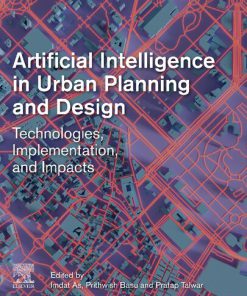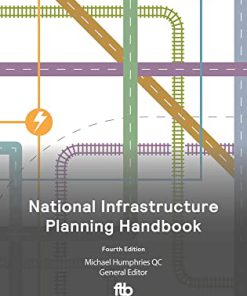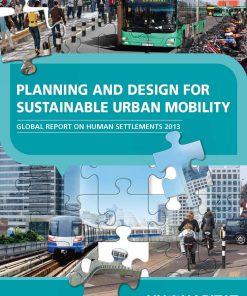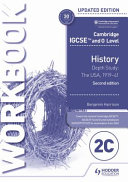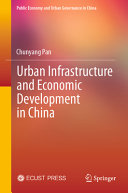Solving Urban Infrastructure Problems Using Smart City Technologies Handbook on Planning Design Development and Regulation 1st Edition by John Vacca ISBN 9780128168165 0128168161
$50.00 Original price was: $50.00.$25.00Current price is: $25.00.
Solving Urban Infrastructure Problems Using Smart City Technologies Handbook on Planning Design Development and Regulation 1st Edition by John Vacca – Ebook PDF Instant Download/Delivery: 9780128168165 ,0128168161
Full download Solving Urban Infrastructure Problems Using Smart City Technologies Handbook on Planning Design Development and Regulation 1st Edition after payment
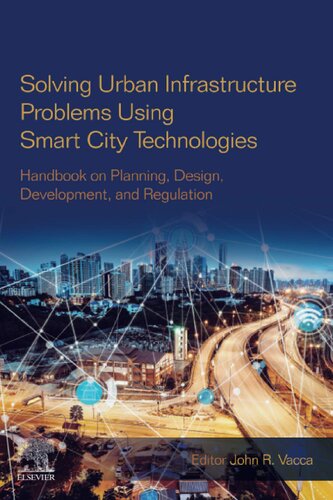
Product details:
ISBN 10: 0128168161
ISBN 13: 9780128168165
Author: John Vacca
Solving Urban Infrastructure Problems Using Smart City Technologies is the most complete guide for integrating next generation smart city technologies into the very foundation of urban areas worldwide, showing how to make urban areas more efficient, more sustainable, and safer. Smart cities are complex systems of systems that encompass all aspects of modern urban life. A key component of their success is creating an ecosystem of smart infrastructures that can work together to enable dynamic, real-time interactions between urban subsystems such as transportation, energy, healthcare, housing, food, entertainment, work, social interactions, and governance. Solving Urban Infrastructure Problems Using Smart City Technologies is a complete reference for building a holistic, system-level perspective on smart and sustainable cities, leveraging big data analytics and strategies for planning, zoning, and public policy. It offers in-depth coverage and practical solutions for how smart cities can utilize resident’s intellectual and social capital, press environmental sustainability, increase personalization, mobility, and higher quality of life.
- Brings together experts from academia, government and industry to offer state-of- the-art solutions for urban system problems, showing how smart technologies can be used to improve the lives of the billions of people living in cities across the globe
- Demonstrates practical implementation solutions through real-life case studies
- Enhances reader comprehension with learning aid such as hands-on exercises, questions and answers, checklists, chapter summaries, chapter review questions, exercise problems, and more
Solving Urban Infrastructure Problems Using Smart City Technologies Handbook on Planning Design Development and Regulation 1st Edition Table of contents:
Part I: Overview of smart cities and infrastructure technologies: a comprehensive introduction
1. Introduction to the critical success factors of E-government adoption of the utilization of emerging smart cities technologies
Abstract
1.1 Introduction
1.2 E-government and M-government
1.3 M-government adoption in developing countries
1.4 Smart government in developing counties: the case of United Arab Emirates
1.5 Conceptual model of smart government adoption
1.6 Conclusion and future research
1.7 Summary
1.8 Chapter review questions/exercises
References
2. Smart-city infrastructure components
Abstract
2.1 Introduction
2.2 Smart-city definitions
2.3 Smart-city key foundations (PILARS)
2.4 Smart-city infrastructure platforms and domains
2.5 Summary
2.6 Chapter review questions/exercises
References
3. Smart buildings and urban spaces
Abstract
3.1 Introduction
3.2 Smart building systems
3.3 Building types in the urban space
3.4 Permits and standards for smart buildings
3.5 Smart building market potentials
3.6 Summary
3.7 Chapter review questions/exercises
References
4. Urban mobility systems components
Abstract
4.1 Introduction
4.2 Mobility, transportation, and accessibility
4.3 Evolution of urban mobility
4.4 Types of transit systems
4.5 The urban mobility challenge
4.6 Urban mobility in the context of sustainability
4.7 Urban mobility in the smart-city age
4.8 Summary
4.9 Chapter review questions/exercises
References
5. Coupling of the mobility and energy infrastructures as urban mobility needs evolve
Abstract
5.1 Introduction
5.2 Trends that shape urban mobility
5.3 An answer from energy and mobility sectors to urbanization and clean trends
5.4 Examples of urban mobility components
5.5 Action recommendations for regulators
5.6 Outlook
5.7 Summary
5.8 Chapter review questions/exercises
References
6. Smart urban mobility traffic control system components
Abstract
6.1 Introduction
6.2 Electric mobility
6.3 Types of electric vehicles
6.4 Electric vehicle supply equipment
6.5 Electric vehicle charging modes
6.6 Summary
6.7 Chapter review questions/exercises
References
7. Urbanization and smart cities
Abstract
7.1 Introduction
7.2 The future of urbanization and need for the smart city
7.3 IoT- and ICT-led initiatives as enablers of smart cities
7.4 Smart cities, urban planning, and policy
7.5 Challenges and opportunities of smart cities
7.6 Conclusion
7.7 Summary
7.8 Chapter review questions/exercises
References
8. Priority activities for smart cities and the infrastructure
Abstract
8.1 Introduction
8.2 Background information
8.3 Generating the market
8.4 Blocks to the market
8.5 Expanding the market
8.6 Greening the market
8.7 Enablers
8.8 Training and involving stakeholders
8.9 Summary
8.10 Chapter review questions/exercises
References
Part II: Planning, design, development and management of smart cities and infrastructure technologies
9. Open Data for smart cities
Abstract
9.1 Introduction
9.2 The rise of urban data
9.3 Open Data, Big Data, Linked Data, and Linked Open Data
9.4 More about Open Data
9.5 National paths to open data
9.6 Open Data value chain
9.7 Eliminating silos by sharing or Open Data
9.8 Data marketplaces
9.9 Conclusion
9.10 Summary
9.11 Chapter review questions/exercises
Acknowledgments
References
10. The role of citizens in smart cities and urban infrastructures
Abstract
10.1 Introduction
10.2 Smart city
10.3 Citizens
10.4 Urban infrastructures
10.5 From passive citizen to active citizens
10.6 Open government
10.7 Governance
10.8 Technological governance
10.9 Hybridizations and changes in citizen governance
10.10 Citizens in the city and urbanism in smart-cities world
10.11 Practical cases
10.12 Corruption and urbanism
10.13 Transparency and citizen role in urbanism and infrastructures
10.14 Superation of citizen participation topics
10.15 Summary
10.16 Chapter review questions/exercises
References
11. Smart city and metropolitan governance
Abstract
11.1 Introduction
11.2 How can cities benefit from cooperation on the smart city subject in a metropolitan area?
11.3 What metropolitan governance arrangement is needed?
11.4 What are the obstacles to collaboration across jurisdictions?
11.5 Application of the intermunicipal cooperation arrangement
11.6 Summary
11.7 Chapter review questions/exercises
References
Part III: Renewable energy technologies for smart cities and the critical infrastructure
12. Distributed energy in smart cities and the infrastructure
Abstract
12.1 Introduction
12.2 Smart cities
12.3 Instrumental procedures in smart cities
12.4 A selection of smart cities standards
12.5 Energy strategy
12.6 Factors affecting energy in smart city
12.7 Smart-city hacking
12.8 Energy efficient designs of sustainable buildings
12.9 Summary
12.10 Chapter review questions/exercises
References
13. Energy efficient automated warehouse design
Abstract
13.1 Introduction
13.2 Literature review
13.3 System description and model assumptions in the system
13.4 Simulation modeling of the system
13.5 Results and discussion
13.6 Suggested future works
13.7 Summary
13.8 Chapter review questions/exercises
Acknowledgment
References
14. Smart utilities
Abstract
14.1 Introduction
14.2 Smart solutions
14.3 Electricity
14.4 Water
14.5 Natural gas
14.6 Summary and business models for utility industry
14.7 Chapter review questions/exercises
References
Part IV: Standardization and regulation of technologies and security for smart cities and the critical infrastructure
15. Smart cities and infrastructure standardization requirements
Abstract
15.1 Introduction
15.2 Data monetization: open data to increase community engagement
15.3 Smart-city technology architecture
15.4 Smart-city application architecture
15.5 Smart energy and light
15.6 Gearing-up for smart health in cities
15.7 City services’ architecture and assets management
15.8 Smart-city data democracy architecture
15.9 Security, privacy, and business continuity concerns of data hub
15.10 Summary
15.11 Chapter review questions/exercises
References
16. Securing smart-grid infrastructure against emerging threats
Abstract
16.1 Introduction
16.2 Emerging cyber threats targeting smart grid
16.3 Security solutions for protecting smart grid
16.4 Supervisory control and data acquisition command authentication as additional line of defense
16.5 Summary
16.6 Chapter review questions/exercises
References
Part V: Smart grid technologies for smart cities and the critical infrastructure
17. Components of the smart-grid system
Abstract
17.1 Introduction
17.2 Components of smart grid
17.3 Summary
17.4 Chapter review questions/exercises
References
18. Introduction to energy management in smart grids
Abstract
18.1 Introduction
18.2 Elements of the smart grid
18.3 Energy management
18.4 Energy management in operational functions
18.5 Energy management challenges
18.6 Energy management standards
18.7 Summary
18.8 Chapter review questions/exercises
References
19. DER, energy management, and transactive energy networks for smart cities
Abstract
19.1 Introduction
19.2 TEN for smart cities—stakeholders, market forces, and technologies
19.3 DER: distributed energy resources
19.4 Evolution of key subsystems for transactive energy
19.5 Digital systems and components—10 enablers
19.6 Smart TE microgrids
19.7 Markets and operators (short and long term)
19.8 Transactive energy strategy and challenges
19.9 Summary
19.10 Chapter review questions/exercises
References
20. Managing the generation and demand inside the smart-grid structure
Abstract
20.1 Introduction
20.2 Energy management techniques in smart grid
20.3 Smart energy management system
20.4 Summary
20.5 Chapter review questions/exercises
References
21. Introduction to energy management in smart grids
Abstract
21.1 Introduction
21.2 Energy management system: the optimization procedure XEMS13
21.3 Case study
21.4 Summary
21.5 Chapter review questions/exercises
References
22. Hybrid renewable energy systems, load and generation forecasting, new grids structure, and smart technologies
Abstract
22.1 Introduction
22.2 Summary
22.3 Conclusions
22.4 Chapter review questions/exercises
References
23. Smart lighting for smart cities
Abstract
23.1 Introduction
23.2 Smart lighting basics
23.3 More advanced concepts
23.4 Smart lighting example
23.5 Potential challenges
23.6 Summary
23.7 Chapter review questions/exercises
References
Part VI: Recommended technologies and solutions for smart cities and the critical infrastructure
24. Smart cities critical infrastructure recommendations and solutions
Abstract
24.1 Introduction
24.2 Critical city infrastructures
24.3 Communications
24.4 Energy (electricity, gas, and oil)
24.5 Water
24.6 Public transportation
24.7 Emergency services
24.8 Summary
24.9 Chapter review questions/exercises
References
25. The city as a commons: the concept of common goods
Abstract
25.1 Introduction
25.2 Defining the topic
25.3 The commons and the OECD
25.4 The commons and the European Union
25.5 Coproduction and the European Social Fund
25.6 The Bologna regulation on public collaboration for urban commons: theoretical basis
25.7 Italy and the commons
25.8 The Bologna regulation on public collaboration for urban commons
25.9 From the commons to the city as a commons
25.10 The cocity index
25.11 Urban innovative action in the city of Turin
25.12 The city of Verona and subsidiarity pacts with active citizens
25.13 The commons and civic crowdfunding
25.14 Best Italian practices in matching public funds with private ones: the city of Milan and Turin
25.15 The role of institutions in promoting civic crowdfunding
25.16 Summary
25.17 Chapter review questions/exercises
References
Part VII: The future of smart cities and the critical infrastructure
26. Resilient future energy systems: smart grids, vehicle-to-grid, and microgrids
Abstract
26.1 Introduction
26.2 Optimization of urban electric grids with EV charging load and V2G generation
26.3 Resilient operational control of microgrids
26.4 Smart grids and digital twins
26.5 Summary
26.6 Chapter review questions/exercises
References
27. Future of connected autonomous vehicles in smart cities
Abstract
27.1 Introduction
27.2 Components of smart city
27.3 Connected and autonomous vehicle functional architecture
27.4 CAV and smart mobility
27.5 CAV and smart energy
27.6 CAV and smart home
27.7 CAV and smart health
27.8 CAV testing and verification platform
27.9 Summary
27.10 Chapter review questions/exercises
References
28. Future developments in vehicle-to-grid technologies
Abstract
28.1 Introduction
28.2 Smart grid
28.3 Vehicle to grid
28.4 State-of-the-art of the V2G
28.5 Charging/discharging strategy
28.6 Summary
28.7 Chapter review questions/exercises
References
29. Designing inclusive smart cities of the future: the Indian context
Abstract
29.1 Introduction
29.2 Review of literature
29.3 Learning from existing global implementations
29.4 Understanding Indian context
29.5 Proposed conceptual model of an inclusive smart city
29.6 Recommendations
29.7 Summary
29.8 Chapter review questions/exercises
References
Part VIII: Appendices
Appendix A. List of top smart cities and critical infrastructure implementation and deployment companies
Appendix B. List of smart cities and critical infrastructure products/projects
Appendix C. List of smart cities and critical infrastructure standards
Appendix D. List of miscellaneous smart cities and critical infrastructure resources
Appendix E. Smart cities and critical infrastructure frequently asked questions
Appendix F. List of smart cities and critical infrastructure case studies
Appendix G. Answers to review questions/exercises, hands-on projects, case projects, and optimal team case project by chapter
G.1 : Introduction to the critical success factors of e-government adoption of the utilization of emerging smart cities technologies
G.2 : Smart-city infrastructure components
G.3 : Smart buildings and urban spaces
G.4 : Urban mobility systems components
G.5 : Coupling of the mobility and energy infrastructures as urban mobility needs evolve
G.6 : Urban mobility system components
G.7 : Urbanization and smart cities
G.8 : Priority activities for smart cities and the infrastructure
G.9 : Open data for smart cities
G.10 : The role of citizens in smart cities and urban infrastructures
G.11 : Smart city and metropolitan governance
G.12 : Distributed energy in smart cities and the infrastructure
G.13 : Energy efficient automated warehouse design
G.14 : Smart utilities
G.15 : Smart cities and infrastructure standardization requirements
G.16 : Securing smart-grid infrastructure against emerging threats
G.17 : Components of the smart-grid system
G.18 : Introduction to energy management in smart grids
G.19 : DER, energy management, and transactive energy networks for smart cities
G.20 : Managing the generation and demand inside the smart-grid structure
G.21 : Energy management of multienergy and hybrid energy networks in smart grids
G.22 : Hybrid renewable energy systems, load, and generation forecasting, new grids structure and smart technologies
G.23 : Smart lighting for smart cities
G.24 : Smart cities critical infrastructure recommendations and solutions
G.25 : The city as a commons: the concept of common goods
G.26 : Resilient future energy systems: smart grids, vehicle-to-grid, and microgrids
G.27 : Connected autonomous vehicles in smart cities
G.28 : Future developments in vehicle-to-grid (V2G) technologies
G.29 : Designing inclusive smart cities of the future: the Indian context
Appendix H. Glossary
Index
People also search for Solving Urban Infrastructure Problems Using Smart City Technologies Handbook on Planning Design Development and Regulation 1st Edition:
urban infrastructure problems
urban infrastructure challenges
problems in urban infrastructure
a solution to urban sprawl
what are urban problems and solutions
Tags:
John Vacca,Urban Infrastructure,Smart City Technologies,Development
You may also like…
Uncategorized
Business & Economics - Project Management
National Infrastructure Planning Handbook 2022 4th Edition Michael Humphries
Engineering - Civil & Structural Engineering
Planning and Design for Sustainable Urban Mobility 1st Edition Un-Habitat
Engineering - Civil & Structural Engineering
Water Systems Analysis, Design, and Planning: Urban Infrastructure 1st Edition Mohammad Karamouz
Education Studies & Teaching - Studying & Test Preparation
Technique - Food Manufacturing
Business & Economics - Economics
Urban Infrastructure and Economic Development in China 1st Edition by Pan 9789819966288 9819966280
Arts - Architecture
Smart Building Design Conception Planning Realization and Operation Maad Bali



